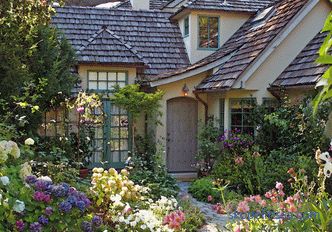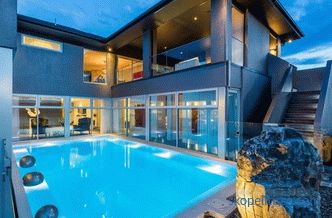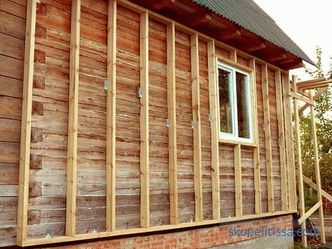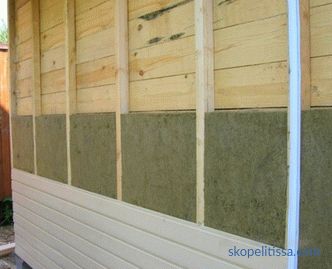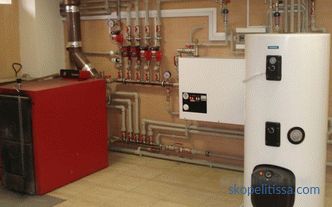Not so long ago, the baths were built with “black” heating. This means that the smoke from the furnace, which heated the entire room, was removed through a small window above the entrance. The slightest malfunction, or just a forgotten window, and smoke immediately filled the entire room. In modern heating systems there is a chimney for the bath, which is made of brick, metal or ceramics. Combustion products are effectively diverted outside the building, even for a moment without getting directly into the heated room. Still, when heating "on white", the heat in the furnace lasts longer, fuel materials are used more economically, ventilation of the room improves.
Design features
Chimneys for the bath stove is constantly being improved, in their manufacture various materials are used, new technologies appear. Knowledge of the features of different modifications allows them to be mounted correctly, to ensure the required fire safety measures, to ensure regular cleaning and replacement of component parts.
By configuration, chimneys are either internal or external. Internal , through the wall are brought out through adapters. The design allows you to save useful space of the room, eliminates the possibility of burns or the fire of internal equipment. But there is also a minus - low efficiency - a considerable share of heat simply "goes" into the atmosphere.
External chimneys are led directly from the furnace to the outside through the ceiling and roof. The required form and direction is given through a variety of fittings, and safety is ensured by the correct selection of insulation in accordance with the norms of SNiP 41-01-2003.
Single-circuit chimneys made of steel
For several reasons (likelihood of condensation, thermal expansion) such devices are practically not used by themselves, but are installed in the form of sleeves for brick pipes. The material is designed for temperatures up to 1100 degrees, has high heat retention parameters. Chimneys are made of stainless, alloyed painted or galvanized steel. Some parts are made of brass.
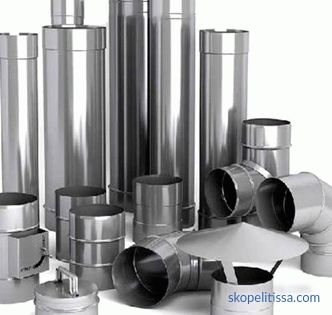
The advantages include:
-
Easy to install.
-
Affordable price.
-
Replaceable parts of the smoke exhaust unit.
-
Low pollution that does not require frequent cleaning of the structure.
-
Possibility of operation in various climatic regions.
The disadvantages include the occurrence of soot on the walls, the formation of corrosive processes. The best material for pipes is steel, which contains at least 17% chromium with a wall thickness of up to 1.5 mm.
Double-walled chimneys-sandwiches made of stainless steel
Proper installation of the chimney in the bath for a wood-burning stove involves the installation is strictly following specific instructions. Otherwise, the wall heater inside the pipe will absorb moisture, which is fraught with negative consequences. Compared with the classic analogue of steel, the sandwich is more reliable and durable.
When purchasing, it is necessary to carefully measure the diameter of the working tube so that it fits the outlet element of the furnace. An important factor is not only the steel grade, but also the type of insulation used. The best option is stone wool. Desired density is 120 kg / cu. m when the thickness of the insulating layer is not less than 40 mm. Pay attention to the assembly. For internal models, it is carried out "by condensate", and for outdoor models, taking into account the smoke output.
On our site you can familiarize yourself with the most popular projects of baths from construction companies presented at the exhibition houses "Low-rise Country".
Installation recommendations
It is forbidden to install the horizontal part of the chimney with a length of more than one meter. The total height of the diversion channel should be more than five meters, which will ensure stable and good traction.
It is forbidden to work with a tool that does not have rubberized insulating surfaces. The design location scheme is worked out in advance. When installing chimneys for a stove in a bath, several important rules are observed:
-
The pipe is not allowed to come into contact with furniture, wallpaper, electrical wiring and other utilities.
-
In the space between the overlap and the crate, an empty space is left (more than 30 cm for uninsulated pipes and at least 15 cm if there is insulation).
-
Contact of the chimney and wood with the outlet channel is not allowed.
-
If the pipe is being laid through an unheated attic room, heat insulation is used to prevent condensation.
-
The chimney should not be placed near combustible and flammable materials.
-
When planning a diversion system, the number of accessories is taken into account, depending on the height of the device.
It might be interesting! In the article on the following link, read about a 6x8 bath with a loft.
Installation nuances
After preparing the tool, unpacking the elements of the chimney with their counting, the experts proceed to the installation of the product.
All work is divided into several stages:
-
Perform marking with determining the distance from the bottom of the furnace to the center of the outlet channel. This parameter is marked on the wall at the location of the firebox.
-
Displays the width of the fuser and the axis of the outlet nozzle with respect to the size obtained.
-
The contours are marked, along which the wall or ceiling will be disassembled, taking fire safety standards into account (a square is drawn with a tape measure, a building level and a pencil.
-
Disassemble the designated part of the wall partition. In the wooden crate, holes are made at the corners and in the center. They are cut with an electric jigsaw using the existing markings.
-
Insulation is cut with a special knife, removed from the wall.
-
The wooden part is protected with non-combustible slabs with a thickness of 30 mm. Cut out round hole for pipe outlet. A suitable flange is used as a template.
-
The protective element is mounted with screws, under which four slots are pre-drilled. Between the wall and the sheet are placed bushings for inserting screws.
-
screen protection is placed on the floor to prevent sparks, heat and embers.
Outside work
From the outside of the bathhouse, the marking of the fragment to be removed is made. Isolation is installed at the point of passage of the pipe through the wall with the required amount of material.
Walls are measured in thickness, strips of basalt wool and foil are cut. They are installed along the prepared contour with a shiny surface inside. When laying mineral wool comply with a minimum of gaps between parts of insulation. The process continues until there remains a hole similar to the diameter of the outlet pipe.
What are the mistakes when installing furnaces, see in the video:
Assembly
The chimney construction is being assembled in parts. At first the bracket fixture, a tee and the horizontal element laid from an oven are connected. Parts are mounted in series, corrugated clamps are sent down. Connection points are treated with a seal that is resistant to increased thermal exposure.
Remove the drip cap, set on the bottom of the tee, fasten with a yoke, do not use sealant. The further assembly procedure consists of the following steps:
-
The straight part of the chimney is fixed to the tee, it will be laid through the wall ceiling.
-
A square flange is installed on the horizontal tube, and the structure is placed in the hole on the wall.
-
By means of the construction level, the verticality and degree of tightening of the fastener are controlled, and the self-tapping screws in the sockets of the triangle brackets are tightened.
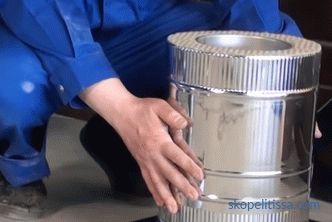
-
The flange is fixed with screws.
-
Increase the construction upwards, connecting the component parts together with clamps and sealant.
-
All nuts reliably tighten as the chimney is constantly exposed to the wind.
-
Mount the bend on the overhang of the roof with a pair of knees with a bend angle of 135 degrees.
-
Assemble three elements, place them on a straight part, fix the upper knee with a clamp.
-
After mounting the straight part, put the deflector and the cone.
-
Further procedure is performed indoors.
-
Mount a single-level pipe with a gate (gate). Connect the outlet of the furnace to it.
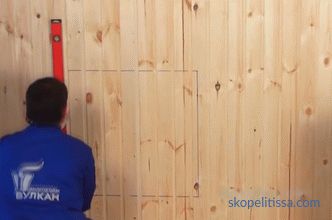
It might be interesting! In the article on the following link read about the bath of expanded clay concrete blocks.
Installation of the internal chimney
The internal chimney is similar to the external one. All connections are made using clamps and sealant. Among the differences in installation:
-
The sheet of insulation fits into its place immediately, a furnace is placed on it. A single-wall pipe or an economizer
-
is connected to the nozzle. A gate element, a water heating tank, a smoke damper, and a heater grid are connected to the direct element.
-
The parts are mounted with the corrugated part down so that the inner element overlaps the wall of the lower compartment. This will protect the insulation from condensate droplets.
-
An important stage in the installation of the chimney is the proper arrangement of the passages through the ceilings and the roof.
Main stages of work
Installation sequence of the internal chimney:
-
The layout of the future chimney on the ceiling is marked.
-
The passage is arranged in accordance with the standards and requirements of the SNiP.
-
A square hole is made.
-
A special dividing box is put on the straight part.
-
About 20 millimeters of free space is left between the vertical walls and the cut socket.
-
The chimney is built up with an additional vertical segment.
-
A box is applied to the ceiling lining and fixed.
-
In the attic, basalt cardboard is laid around the dividing part, and in the inner part - expanded clay or mineral wool.
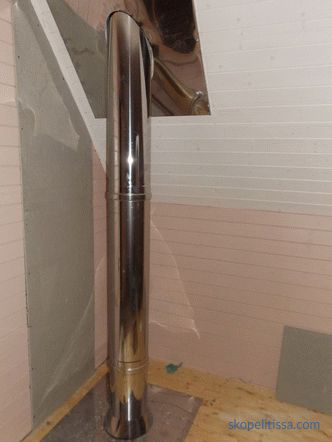
Commissioning
Chimney needed inspect, pay special attention to the quality and density of the joints. Inside the structure is cleaned with a dry cloth. All excess items from the chimney and firebox are removed. Test ignition is carried out using a small amount of fuel. At this stage, determine the effectiveness of thrust, the presence of smoke in the joints, drawing it into the room.
After testing, after a few hours, the furnace is fully heated. Do not shove used combustible materials "to the eyeballs" into the furnace, this may lead to chimney failure and fire. All combustible elements and partitions near the pipe should be insulated, the distance between them and the exhaust structure should be at least half a meter. Visual inspection and preventive cleaning is carried out once every six months.
About the installation of fireproofing “fuzzing” in the following video:
On our website you can find contacts of construction companies that offer the service installation of stoves and fireplaces . Directly to communicate with representatives, you can visit the exhibition of houses "Low-rise Country".
Conclusion
A properly selected and mounted chimney is a guarantee of high-quality operation of the stove in your bath. It is highly recommended to carry out the installation by professionals who will do everything quickly, and above all qualitatively, and will give a written guarantee for their work.
